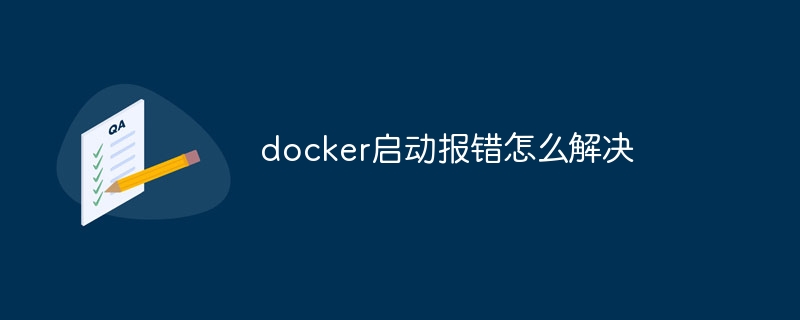How to solve the error in docker startup
Resolve Docker startup failure: 1. Run Docker with root user permissions; 2. Check port conflicts and adjust port numbers; 3. Clean unused images and volumes to free up storage space; 4. Increase Docker allocated memory; 5. Install required dependencies; 6. Check the correctness of volume mounts; 7. View container logs for error information; 8. Update the kernel version to comply with Docker requirements.

Docker startup error resolution guide
1. Startup failed: Permission issue
- Workaround: Use
sudoto run the Docker command with root user permissions.
2. Startup failed: Network conflict
- Workaround: Check whether the Docker daemon listens for the correct port. If you have used another application, change the port number of Docker or stop the conflicting application.
3. Startup failed: insufficient storage space
- Workaround: Free up Docker storage space. This can be done by cleaning up unused images and volumes.
4. Startup failed: insufficient memory
- Workaround: Increase the memory allocated by Docker. You can edit the
/etc/default/dockerfile and modify theDOCKER_OPTSvariable to set higher memory limits.
5. Startup failed: Dependencies are missing
- Workaround: Install the dependencies required for Docker. On Ubuntu/Debian systems, run
sudo apt-get install docker-ce docker-ce-cli.
6. Startup failed: volume mount failed
- Workaround: Make sure the volume exists and is mounted correctly. Use
docker inspectcommand to check the volume information of the container.
7. Startup failed: container error
- Workaround: Check the container's log for detailed error information. You can use
docker logscommand to view the logs.
8. Startup failed: Kernel version is incompatible
- Workaround: Update the kernel version to comply with Docker requirements. Some Docker versions require specific kernel versions to function properly.
The above is the detailed content of How to solve the error in docker startup. For more information, please follow other related articles on the PHP Chinese website!

Hot AI Tools

Undresser.AI Undress
AI-powered app for creating realistic nude photos

AI Clothes Remover
Online AI tool for removing clothes from photos.

Undress AI Tool
Undress images for free

Clothoff.io
AI clothes remover

Video Face Swap
Swap faces in any video effortlessly with our completely free AI face swap tool!

Hot Article

Hot Tools

Notepad++7.3.1
Easy-to-use and free code editor

SublimeText3 Chinese version
Chinese version, very easy to use

Zend Studio 13.0.1
Powerful PHP integrated development environment

Dreamweaver CS6
Visual web development tools

SublimeText3 Mac version
God-level code editing software (SublimeText3)

Hot Topics
 How to exit the container by docker
Apr 15, 2025 pm 12:15 PM
How to exit the container by docker
Apr 15, 2025 pm 12:15 PM
Four ways to exit Docker container: Use Ctrl D in the container terminal Enter exit command in the container terminal Use docker stop <container_name> Command Use docker kill <container_name> command in the host terminal (force exit)
 How to copy files in docker to outside
Apr 15, 2025 pm 12:12 PM
How to copy files in docker to outside
Apr 15, 2025 pm 12:12 PM
Methods for copying files to external hosts in Docker: Use the docker cp command: Execute docker cp [Options] <Container Path> <Host Path>. Using data volumes: Create a directory on the host, and use the -v parameter to mount the directory into the container when creating the container to achieve bidirectional file synchronization.
 How to check the name of the docker container
Apr 15, 2025 pm 12:21 PM
How to check the name of the docker container
Apr 15, 2025 pm 12:21 PM
You can query the Docker container name by following the steps: List all containers (docker ps). Filter the container list (using the grep command). Gets the container name (located in the "NAMES" column).
 How to restart docker
Apr 15, 2025 pm 12:06 PM
How to restart docker
Apr 15, 2025 pm 12:06 PM
How to restart the Docker container: get the container ID (docker ps); stop the container (docker stop <container_id>); start the container (docker start <container_id>); verify that the restart is successful (docker ps). Other methods: Docker Compose (docker-compose restart) or Docker API (see Docker documentation).
 How to start mysql by docker
Apr 15, 2025 pm 12:09 PM
How to start mysql by docker
Apr 15, 2025 pm 12:09 PM
The process of starting MySQL in Docker consists of the following steps: Pull the MySQL image to create and start the container, set the root user password, and map the port verification connection Create the database and the user grants all permissions to the database
 How to update the image of docker
Apr 15, 2025 pm 12:03 PM
How to update the image of docker
Apr 15, 2025 pm 12:03 PM
The steps to update a Docker image are as follows: Pull the latest image tag New image Delete the old image for a specific tag (optional) Restart the container (if needed)
 How to create containers for docker
Apr 15, 2025 pm 12:18 PM
How to create containers for docker
Apr 15, 2025 pm 12:18 PM
Create a container in Docker: 1. Pull the image: docker pull [mirror name] 2. Create a container: docker run [Options] [mirror name] [Command] 3. Start the container: docker start [Container name]
 How to start containers by docker
Apr 15, 2025 pm 12:27 PM
How to start containers by docker
Apr 15, 2025 pm 12:27 PM
Docker container startup steps: Pull the container image: Run "docker pull [mirror name]". Create a container: Use "docker create [options] [mirror name] [commands and parameters]". Start the container: Execute "docker start [Container name or ID]". Check container status: Verify that the container is running with "docker ps".






